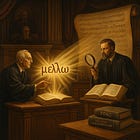Mellō Yellow : Grammar in a Vacuum
Divorcing Timing from Nature
Another major flaw in Gary DeMar’s approach is his tendency to divorce the timing of events from their theological nature—as if one can discuss "when" without ever addressing "what." He treats Greek grammar in a vacuum, isolating words like mellō from the grand theological realities they reference, such as the resurrection of the dead. This pattern is especially evident in his handling of Acts 24:15. Gary fixated on whether mellō in mellein esesthai anastasin should be translated as "about to be a resurrection," but he carefully avoided the follow-up question: What is the resurrection that Paul and the Pharisees hoped for? By severing the timing from the nature of the event, Gary sidesteps the doctrinal implications of his interpretation.
This is no minor oversight—it is a deliberate evasion. If Gary claims that the general resurrection was "about to" happen in Paul's day (and did happen in AD 70, per hyper preterism), he must reckon with the theological meaning of that resurrection. The Pharisees Paul referenced in Acts 24:15 were firm believers in a bodily resurrection. Paul affirms this alignment when he states that he has "a hope in God, which these men themselves accept," namely, "that there will be a resurrection of both the just and the unjust." There is no evidence that the Pharisees spiritualized this hope in the way hyper-preterists do. They anticipated a literal, future resurrection of the dead. Paul grounds his defense on the assertion that his Christian hope is not novel, but in full continuity with this historic Jewish expectation, fulfilled in Christ.
By wrenching the timing phrase out of its theological context, Gary ignores the central problem: if the general resurrection occurred in AD 70, as hyper-preterists insist, it was not the resurrection the Pharisees anticipated. Paul based his defense on their shared belief in a bodily resurrection of both righteous and wicked. If he meant instead a spiritualized, invisible event, then Paul was misleading and the Pharisees were astonishingly oblivious to the redefinition. Either way, Gary's interpretation empties Paul's argument of its force. It makes Paul deceptive and the Pharisees foolish, collapsing the entire rhetorical weight of his courtroom appeal.
Furthermore, Gary neglects to ask why Paul raised the subject of resurrection at all. Acts 23:6-10 explains Paul’s strategic appeal:
Now when Paul perceived that one part were Sadducees and the other Pharisees, he cried out in the council, “Brothers, I am a Pharisee, a son of Pharisees. It is with respect to the hope and the resurrection of the dead that I am on trial.” And when he had said this, a dissension arose between the Pharisees and the Sadducees, and the assembly was divided. For the Sadducees say that there is no resurrection, nor angel, nor spirit, but the Pharisees acknowledge them all. Then a great clamor arose, and some of the scribes of the Pharisees’ party stood up and contended sharply, “We find nothing wrong in this man. What if a spirit or an angel spoke to him?” And when the dissension became violent, the tribune, afraid that Paul would be torn to pieces by them, commanded the soldiers to go down and take him away from among them by force and bring him into the barracks.
Paul's move was shrewd. By siding with the Pharisees on the doctrine of resurrection—a view they embraced and the Sadducees rejected—he fractured his opponents, turning their hostility inward and away from himself. That tactic only worked because Paul genuinely shared the Pharisees' belief. Had his concept of resurrection differed radically from theirs, the resulting solidarity would have evaporated. The Pharisees’ declaration, "We find nothing wrong in this man," confirms that Paul stood on common theological ground. He was not announcing a soon-to-be redefinition, but appealing to an agreed-upon hope.
Throughout his responses, Gary continues to treat Greek grammar as if it exists in a doctrinal vacuum. He reduces mellō to a mathematical problem for lexicons and interlinears to solve, while avoiding the question of what resurrection actually means. This inconsistency is glaring. Gary has even admitted that he has not done serious exegetical work on 1 Corinthians 15, the single most detailed chapter in Scripture on the nature of the resurrection. In a candid moment, he acknowledged that he does not understand what Paul is saying there.
Think about that: 1 Corinthians 15 is Paul’s magnum opus on the resurrection—its nature, its necessity for the gospel, and its eschatological place. Yet Gary, by his own admission, doesn’t understand it. Nevertheless, he confidently asserts that Acts 24:15 proves an imminent resurrection. This is backwards. He is timing an event whose theological content he has not bothered to understand. It is, as I wrote, a serious inconsistency. How can one credibly claim to be interpreting Scripture with Scripture while avoiding passages that most fully explain the doctrine in question?
By sidestepping 1 Corinthians 15 and other key texts like John 6—where Jesus affirms that He will “lose nothing of all that he has given me” and repeats four times that He will “raise [the believer] up on the last day”—Gary attempts to separate the timing of the resurrection from its nature as defined elsewhere in Scripture. He focuses solely and superficially on one supposed “timing” verb while ignoring both the broader theological context and the nature of the resurrection, which is not only stated explicitly in texts like 1 Corinthians 15 but also implied in Acts 24. But that division cannot hold. In theology, timing is inseparably tethered to nature.
He fixates on a single gloss of one word but fails to explain what he believes actually happened to the righteous and the wicked in AD 70. This is not careful exegesis; it is theological evasion. It is a method of focusing on syllables to avoid the substance.
Only after these few exchanges has Gary begun to outline the implications of his position. He now speculates that “about to” in Acts 24:15 refers to the Old Covenant saints being confined in Hades until AD 70, when they were finally “raised” to heaven and given resurrection bodies. But this view runs headlong into the biblical definition of resurrection. A new body that has no ties to the old body isn’t a resurrected body—it’s not one that has been transformed from mortality to immortality, from dishonor to glory. As Paul writes in 1 Corinthians 15, “what is sown is perishable; what is raised is imperishable… it is sown a natural body; it is raised a spiritual body” (1 Cor 15:42–44, ESV). Resurrection of the body in 1 Corinthians 15 is not about relocation of the soul to put on a new suit; it is about the transformation of our present fleshly body.
Moreover, Gary’s proposal simply relocates the very problem he uses to criticize others. If the saints did not receive resurrection bodies until AD 70, then they remained disembodied for centuries. In trying to avoid the notion of a bodiless intermediate state, he merely pushes it back into the Old Covenant era—retaining the very condition he condemns.
The irony is hard to miss. Gary and Eric accuse orthodox Reformed theology of Gnosticism for teaching that believers dwell with Christ in spirit while awaiting the resurrection. Yet their own view affirms the same disembodied state—just prior to AD 70 rather than after. Historic Christianity teaches that the souls of the faithful await a future bodily resurrection, not that the body is permanently discarded. It is Gary’s view, not ours, that strips resurrection of its physical substance. The Gnosticism charge, if it lands anywhere, lands squarely on his position.
Despite his repeated claims to the contrary, I have met Gary's challenge. I have consistently argued that both context and theology must inform how we understand mellō. And in Acts 24:15, the context supports a translation that emphasizes certainty, not necessarily imminence. That is why the vast majority of English versions render the phrase something along the lines of "there will be a resurrection" — highlighting the surety of the hope, not its proximity.
Acts 24:15 is not a forecast of a short-term crisis. It is a theological affirmation: Paul shares the Pharisees' hope in the resurrection of all the dead. Paul's entire point in referencing the resurrection was to show his solidarity with the Pharisees against the resurrection-denying Sadducees, thereby stirring conflict between the two factions and redirecting the hostility away from himself. His emphasis was on the certainty of the resurrection, not the timing. That certainty served both as a strategic defense and as a theological declaration of shared hope. The syntax underscores the certainty of this event, not its nearness. The theological nature of the resurrection governs the force of mellō in that passage. Gary’s error is treating mellō as if it must always mean “about to happen immediately,” regardless of the immediate or broader context. But that's not how language works, and it is certainly not how theology works. Timing and nature are intertwined. By separating them, Gary ends up with an interpretation that creates far more doctrinal problems than it solves.
In the end, Gary's refusal to address the nature of the resurrection reveals the deep instability of his eschatology. He wants to speak only about "when," as if timing can be settled apart from meaning. But a doctrine of "when" always implies a doctrine of "what." His unwillingness to state clearly what he believes occurred in AD 70—and how that constitutes the resurrection of both just and unjust—exposes the cracks in his so-called "consistent preterism."
In my next segment, I’ll address lexicons, interlinears, and one-man translations.






